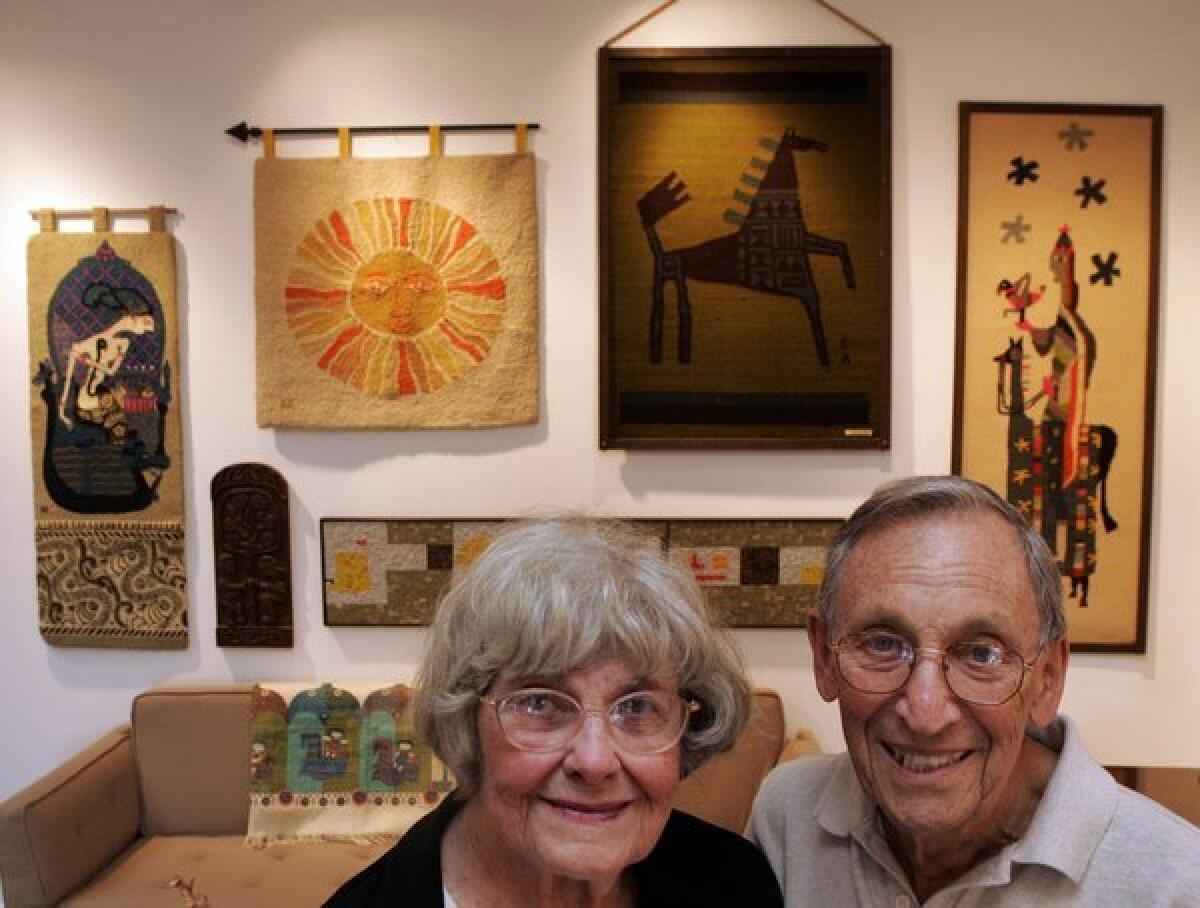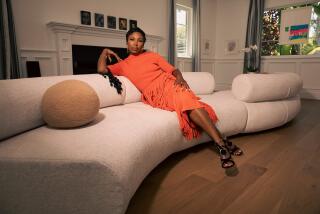Remembering Evelyn Ackerman, a midcentury master of craft

- Share via
As a drizzle fell outside, family and friends gathered on Sunday to celebrate the life and work of Evelyn Ackerman in the Culver City home she shared with her husband, Jerome, since 1956. Hanging above the fireplace was “Rain,” one of her finest mosaics — and for an artist of unbridled optimism, one of her moodiest — showing two figures scurrying through a downpour under umbrellas.
Across the room, in a book-lined corner, a nearly life-size 1954 photograph captured Evelyn and Jerome at work, unloading ceramics from a kiln. Wearing jeans and sneakers and a fashionable bob hairdo, she exuded the gamin grace and bohemian chic that Audrey Hepburn would bring to the screen as a beatnik-turned-model in “Funny Face.”
Though those who had gathered were mourning the artist’s death on Wednesday at age 88, the house was alive with appreciation for what Evelyn had helped to create: a soulful and wonderful home built with artistry on the foundation of a deep, devoted love.
PHOTOS: Evelyn Ackerman and her work
I had been to the Ackermans’ home before, most memorably on a March afternoon in 2009, when I interviewed them for an article and photo gallery for The Times’ Masters of Craft series. Though theirs was a relatively modest middle class house, the Ackermans had transformed it with magical details: sculpted wood pieces from their Panelcarve collection, their own hardware design on kitchen cabinets, souvenirs from their travels, Jerome’s sleek ceramics and Evelyn’s mosaics, stained glass, cast metal plaques and wall hangings, as well as her vast collection of antique dolls.
Back then, I pored over a hand-woven tapestry of a cat chasing a bird up a tree — a typical example of Evelyn’s style, which married childlike wonder and a sophisticated sense of illustration and design. As I walked through the house, I peppered them with questions, eager for details. I told them on many an occasion that I was somewhat shocked that these timeless designs had not been snatched up for reissue by mass retailers. Modestly, Evelyn expressed surprise that people might be interested in work she had done so long ago.
Jerry, as he is known to friends, took it in stride and proudly recalled his wife’s explorations of materials — fabric, wood, clay, metal — and broad range of subject matter, including geometric abstracts and storybook and biblical characters. A garrulous storyteller, he was quick with a joke, and Evelyn was his foil. Somewhat shy but often smiling, she listened attentively to oft-told anecdotes, often adding a sly riposte. (After her husband recounted how, in their first years in Los Angeles, she toiled answering fan mail for the comedian Red Skelton, Evelyn simply added, “He wasn’t that funny.”)
I first met Evelyn at the Los Angeles gallery Reform in 2006. Owner Gerard O’Brien, who has been a champion of the Ackermans, invited me to see an exhibition of post-World War II California design and asked if I would like to meet the couple. I was already familiar with Evelyn’s mosaics and tapestries, coveting them whenever I spotted them in auction catalogs or design stores. When I arrived, Jerry was laying out ancient clippings from the old L.A. Times Home magazine. I noticed one of their sale brochures and spotted the logo of J.L. Hudson, the most upscale department store of my childhood in Detroit.
“Oh,” I said, “You sold your work at my department store?”
“I didn’t know you owned it,” Jerry wisecracked. “Are you from Detroit? We are.”
“Yes,” I said. “You probably went to Central High, like my parents. Did you know Leo Keeps or a girl named Frances Goldberg?”
“I think I asked her out once,” he responded.
“Oh, Jerry,” Evelyn said, swatting his arm playfully.
I don’t normally carry a cellphone into an interview, but that day, I’m glad I did. I dialed my folks back in Detroit and asked them if they remembered the Ackermans.
“He was class president,” my father answered.
“Hand it over,” Jerry said, reaching for the phone.
On my parents’ next visit to Los Angeles, we visited the Ackermans at home and had lunch at their local deli, Roll ‘n Rye. Listening to them swap stories about the Depression, the war and the Ackermans’ courageous move to build a career as artists and designers in Los Angeles, I was impressed with the fortitude and determination beneath Evelyn’s quiet demeanor. Decades before e-commerce, Etsy, celebrity licensed-home decor and the concept of branding, she was able to make a successful living as an artist and leave an indelible mark on the world of decorative arts.
Evelyn could not have done it without her adoring husband, she often said. He would be astonished coming home to find stacks of illustrations on her work table; she marveled at his ability to produce and sell their creations. In work, as in life, they were each other’s complement.
“My mom and dad are like salt and pepper,” daughter Laura Ackerman once told me. “She’s the salt of the earth, and he spices things up.”
In recent years, Jerry and Evelyn had been rediscovered by a new generation of design enthusiasts and revered as vital contributors to the California modernism and studio craft movements. Their work has been shown at the Los Angeles County Museum of Art and the Craft and Folk Art Museum in L.A., and Evelyn’s designs are currently on display in “California’s Designing Women” at the Autry National Center. They invited me to special occasions, and I drove to San Diego to see their 2009 retrospective at the Mingei International Museum.
Though they were often busy cataloging their work for museum shows, Evelyn and Jerry were warm and welcoming, inviting me to bring friends over. They could often be seen at design events around Los Angeles. “Hey kiddo,” Jerry would say on the phone, “Evie and I are going to the Eames Office. Will we see you there?”
Inevitably, they would. I’d spot them out and about, the life of the party — Evelyn always wearing the abstract silver pendant she designed and made in college in 1945, a dapper and doting Jerry holding his sweetheart’s hand. In 2008, the Museum of California Design honored the Ackermans with a Henry Award for outstanding contributions to American design. I took my parents, who were in town, to the benefit reception and auction held in a house that architect A. Quincy Jones built for film star Gary Cooper in 1955, the year I was born. It was a beautiful day, made all the more special by two impulse purchases: I bought my parents a painting, and they, in turn, purchased a piece for me with two wooden bas relief birds. On the back it reads in a meticulous hand: “Panelcarve. Evelyn Ackerman Design 1965.” It hangs by my bedside — the last thing I gaze upon before I go to sleep and the first thing I see when I wake up. I have loved its artistry since the day I brought it home, and I treasure it now as a remembrance of Evelyn Ackerman’s immense talent and her warm, enduring spirit.
We welcome story suggestions at home@latimes.com.


